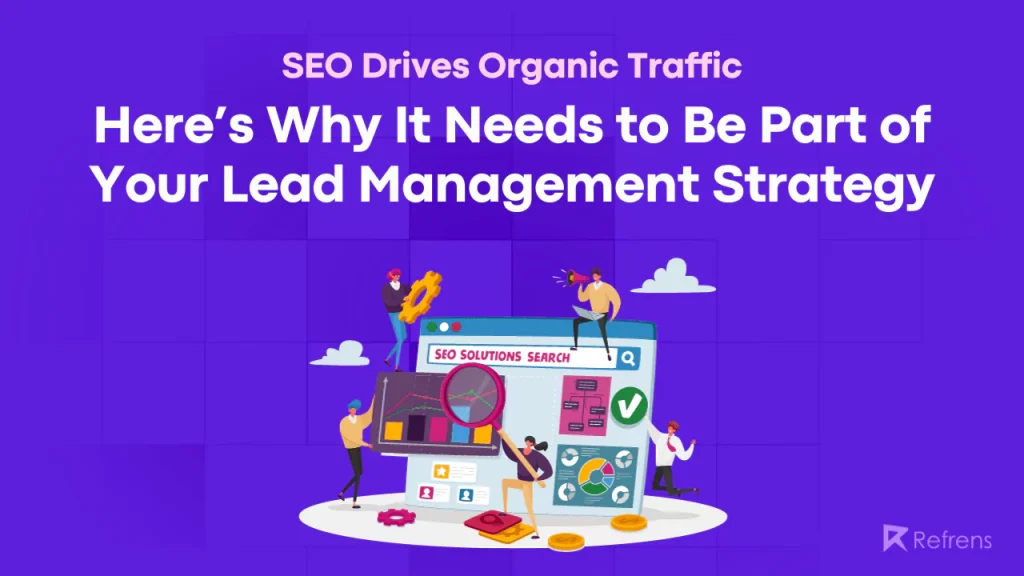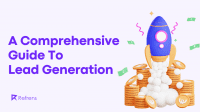Optimizing Your Site for Connections, Speed, Relevance, UI/UX, and Responsiveness Brings Traffic, Leads, and Sales
Leads can come from paid traffic (ads on social media sites or pay-per-click ads) or organic (unpaid) traffic from social media posts or web searches.
Paid traffic can reach a defined demographic who are your ideal customers.
However, it can become expensive, and it is challenging to build the relationships with customers that are necessary for repeat business. Although organic traffic is more of a long-term investment, it generates trust in potential customers and can establish you as an authority in your field.
In 2019, a report by BrightEdge found that, on average, across industries, 53.3% of website traffic is organic and that organic search traffic gives B2B companies twice the income of paid sources.
Organic traffic yields an excellent return on investment, provided you create high-quality content and employ search engine optimization (SEO) to accomplish two major goals: firstly, to rank higher in search engine results pages (SERPs), and secondly, to offer more value to site visitors.
Remember: search engines prioritize web pages that benefit search users.
Here’s why effective SEO needs to be part of your lead management strategy.
Five Factors for Search Engine Optimization
These five factors are far from all there is to search engine optimization. The Google algorithm covers hundreds of different aspects of a website, and the algorithm changes multiple times a day.
However, to avoid being overwhelmed by the task, focus on the most critical aspects of SEO first.
1. Connections, Including Backlinks
The most significant advantage of hypertext on the web over conventional text in a book is connectivity! Hypertext has links, while ordinary text does not.
Links are exactly what their name implies: they link one page to another as part of the vast entity that is the internet, enabling you to go anywhere. But not all places you can go on the net are equally valuable.
If you are generating high-quality content as part of your ongoing SEO strategy to deliver value and rank higher, then having links to other sites with high-quality content (and thus high domain authority) helps to boost your site’s rankings. Collaborating with an SEO agency can further enhance this strategy by ensuring that the links and content align with best practices for search engine optimization.
Human visitors reading your site may overlook the quality of your links, but the search engine “spiders” crawling your site to index it in the SERPs do not.
Do:
- Link to high-quality sites that add value to your readers.
- Reach out to high-domain authority sites to ask about guest posting opportunities or you can also hire a SaaS Link building agency or a professional for link building service.
Don’t:
- Link to low domain authority sites.
- Link to sites that may host viruses, malware, scams, etc.
- Engage in backlink spamming.
2. Speed
We live in an increasingly fast-paced world. People would rather get a satisfactory answer in five seconds than an excellent one in fifteen. If your site takes too long to load, they will leave.
The resulting increased bounce rate hurts your SERP rankings because search engines want to send users to sites they engage with.
Search engines also evaluate your site’s speed directly. Google has built its business model around several factors, but one of the critical parts of its dominance among search engines is how quickly it delivers results.
Their assessment of Core Web Vitals signals affects how they rank sites. A slow site gets penalized, and a fast site is boosted.
There are many ways that a website can slow down: too many plug-ins, media files that are not optimized, and data-intensive themes. A beautiful site that leads do not see is worthless.
Do:
- Run a content management system (CMS) and theme light on resources.
- Simplify your sites – reduce the number of plug-ins.
- Optimize and compress media files such as pictures.
Don’t:
- Use complex, data-heavy animations.
- Use large media files.
- Create an impressive site at the expense of speed.
3. Relevance
The more your page matches people’s search intent, giving them what they are looking for, the more likely they are to buy from you. You provide value with high-quality content, build trust, and show potential customers that you can solve their pain points.
This assurance that you can address their needs results in increased lead conversion.
Matching Search Intent
How do you ensure that your content matches search intent? Using keywords (note that many so-called keywords are phrases).
Keywords enable the search engine spiders that crawl and index your page to understand your page. This allows them to categorize you as a good fit for internet users searching for those keywords – in other words, that your content is relevant and matches user intent.
Keyword research is a vast field on its own, but a foundational principle is that you must use keywords that people are searching for but that only a few competitors are using.
To adapt a classic saying, you want to be a tasty fish in a small pond.
The Goldilocks Factor and Keyword Choice
High-volume keywords may match user search intent, but your page will share them with too many competitors, reducing the chances that search engine users will find you. You may be tasty, but the pond is too big, so there are too many other fish in it with you.
On the other hand, if too few people are searching for the keywords you are using, your site may not appear on the SERPs for topics you provide valuable content about.
You might be the tastiest fish ever, but you’re in a roadside puddle that nobody is fishing in.
Therefore, the sweet spot for keywords lies with words that a high proportion of your ideal customers are already searching for but that you do not share with too many competing businesses. Keyword research tools such as Semrush and Ahrefs enable you to identify these keywords.
The more keywords you have that match ideal customers’ search intent, the more high-quality traffic you will get, leading to more conversions.
Why Keyword Stuffing Is a Bad Idea
In the old, wild internet, unscrupulous website owners created content that was “stuffed” with keywords. It appeared to be a perfect match for what people were looking for, but the content was unreadable when they arrived at the page because it was full of keywords and nothing else.
Search engines quickly got wise to such unethical tactics and began actively penalizing sites that used keyword stuffing. Currently, a maximum of three percent of the text on a page may be any one keyword.
Anything more results in search engines pushing your website down the SERP rankings, which is terrible for traffic.
Do:
- Use keywords that people are searching for.
- Use keywords that accurately describe your content.
Don’t:
- Use keywords that are seldom used.
- Use keywords that everyone is using.
- Stuff content with keywords – keep the frequency of any one keyword below three percent.
4. UI/UX
Making a site a pleasure for humans to interact with affects its rankings in many ways, some of which are less obvious than others.
Reducing Clutter
An uncluttered site makes it easier for people to find what they are looking for (which benefits you as the site owner, too). It prevents them from being overwhelmed or distracted by too much visual clutter, hideous color schemes, or annoying pop-ups.
Improving UI (user interface) and UX (user experience) affects how both humans and search engines perceive your website. Search engines enjoy coherent structure – it lets them know that humans will like this layout, too.
Meanwhile, a site that is easy on the eye and easy to navigate means that humans stay longer. This increases your dwell time, reduces your bounce rate, and is excellent for your SERP rankings.
Optimizing For Your Readers
User interface and user experience are vast subjects, but we can describe some fundamentals.
Our eyes move in predictable patterns when reading: anyone used to reading from left to right, top to bottom, will glance over your web pages in a “Z” motion.
We do not like visual clutter, such as a wall of text.
Our eyes are drawn by a bright color that stands out from everything else. Using the digital equivalent of a flare allows you to highlight things such as your call to action (CTA), notices of an upcoming discount sale or product release, and so on.
Three bright impact colors are only 33 percent as effective as one.
We want to find things easily and understand how to achieve a particular outcome.
Do:
- Place important information, such as menus, at the top.
- Place a CTA above the fold, preferably at the top right.
- Place a couple more CTAs; the bottom right corner is another good place for one.
- Break text into short paragraphs.
- Use bullet points or numbered lists.
- Structure your content with headings.
- Add interest and clarity by inserting visual elements such as photos and graphs.
- Use a simple color scheme.
- Use a single impact color to highlight essential elements such as your CTA.
- Use a straightforward, uncluttered menu (and sub-menus) so users can find pages on your site.
- Build good search functionality into your site.
- Consider using an AI chatbot to help your site visitors with queries – this can increase lead conversion substantially.
- Provide clear instructions for site visitors regarding any actions you want them to take.
Don’t:
- Use a wall of text.
- Use a small font.
- Use a typeface that is hard to read.
- Use a lot of colors (especially bright ones).
5. Responsiveness
An enormous number of searches are from mobile devices. In 2016, a report from Hitwise found that around 60 percent of web searches were from a cell phone or tablet. As such, mobile responsiveness (the ability of a site to adapt its layout to fit a mobile device’s screen) is vital to good lead management.
Not only is it painful for potential customers to try and navigate a site that is not responsive, but search engines may also penalize sites that are not responsive.
With so many searches coming from mobile devices, a site that is not responsive leaves a lot of leads on the table. And yet, many business site owners still overlook this aspect of SEO.
Several aspects of mobile responsiveness overlap with those we have already touched on. One cannot create a site and slap responsiveness on as an afterthought.
Do:
- Make a mobile responsive site for your business.
- Consider mobile devices when designing UI and UX.
- Create a light, fast site that mobile devices can handle easily.
Don’t:
- Build a site that does not adapt its layout to fit mobile screens.
- Design a site that is difficult to read in smaller sizes.
Wrapping Up
Making mistakes in these five critical areas of SEO isn’t something your business can afford.
Implementing best practices to enhance your site’s quality and performance draws more organic traffic and dramatically increases lead generation. While not every site visitor is an automatic conversion, the leads you get are usually high-quality, and conversion rates are higher.
SEO is essential to lead management – but you need to be prepared to welcome your new influx of leads.
You need efficient, excellent lead management software that moves leads through the sales funnel. Discover how Refrens Lead Management Software can help.


















